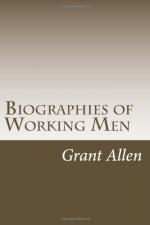Roscoe had a splendid collection of prints and drawings at Allerton; and he invited the clever Welsh lad over there frequently, and allowed him to study them all to his heart’s content. To a lad like John Gibson, such an opportunity of becoming acquainted with the works of Raphael and Michael Angelo was a great and pure delight. Before he was nineteen, he began to think of a big picture which he hoped to paint some day; and he carried it out as well as he was able in his own self-taught fashion. For as yet, it must be remembered, Gibson had had no regular artistic instruction: there was none such, indeed, to be had at all in Liverpool in his day; and there was no real art going on in the town in any way. Mr. Francis, his master, was no artist; nor was there anybody at the works who could teach him: for as soon as Mr. Francis found out the full measure of Gibson’s abilities, he dismissed his German artist Luge, and put the clever boy entirely in his place. At this time, Gibson was only receiving six shillings a week as wages; but Mr. Francis got good prices for many of his works, and was not ashamed even to put his own name upon the promising lad’s artistic performances.
Mr. Roscoe did not merely encourage the young sculptor; he set him also on the right road for ultimate success. He urged Gibson to study anatomy, without which no sculpture worthy of the name is possible. Gibson gladly complied, for he knew that Michael Angelo had been a great anatomist, and Michael was just at that moment the budding sculptor’s idol and ideal. But how could he learn? A certain Dr. Vose was then giving lectures on anatomy to young surgeons at Liverpool, and on Roscoe’s recommendation he kindly admitted the eager student gratis to his dissecting-room. Gibson dissected there with a will in all his spare moments, and as he put his mind into the work he soon became well versed in the construction of the human body.
From the day that Gibson arrived at man’s estate, the great dream of his life was to go to Rome. For Rome is to art what London is to industry—the metropolis in its own way of the entire earth. But travelling in 1810 cost a vast deal of money; and the poor Liverpool marble-cutter (for as yet he was really nothing more) could hardly hope to earn the immense sum that such an expedition would necessarily cost him. So for six years more he went on working at Liverpool in his own native untaught fashion, doing his best to perfect himself, but feeling sadly the lack of training and competition. One of the last works he executed while still in Mr. Francis’s service was a chimney-piece for Sir John Gladstone, father of the future premier. Sir John was so pleased with the execution, that he gave the young workman ten pounds as a present. But in spite of occasional encouragement like this, Gibson felt himself at Liverpool, as he says, “chained down by the leg, and panting for liberation.”




